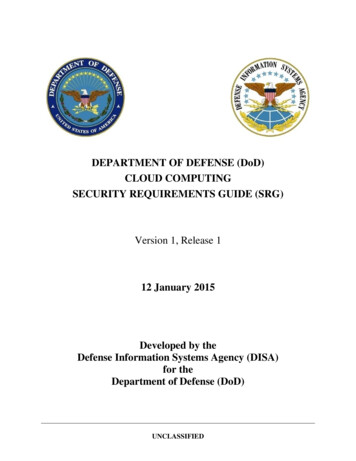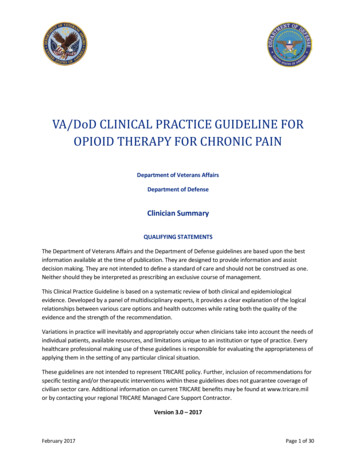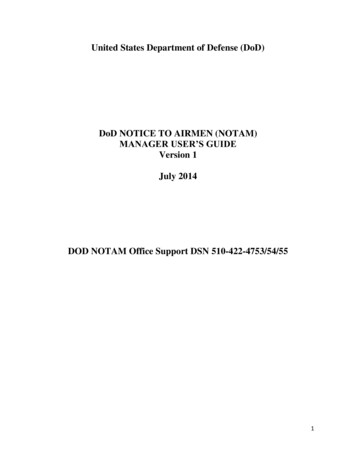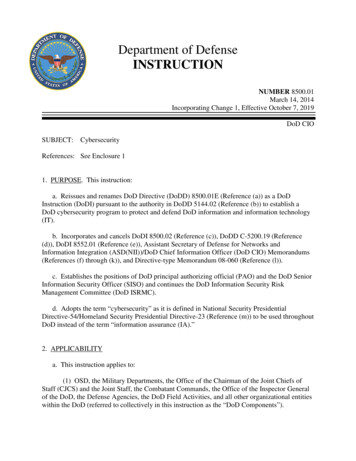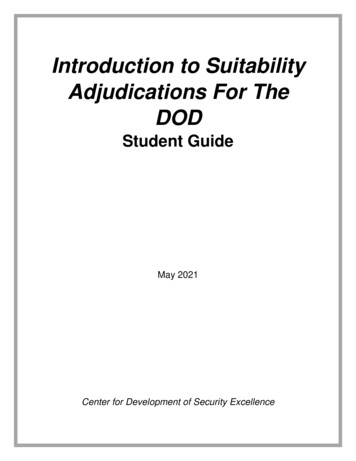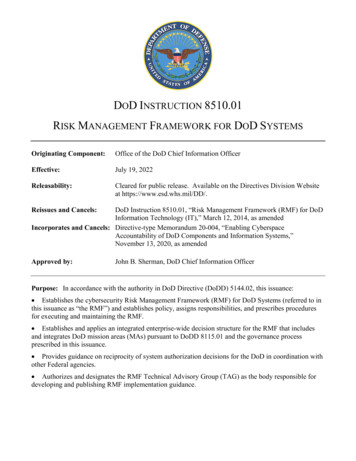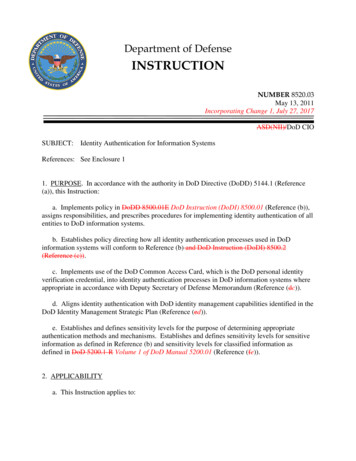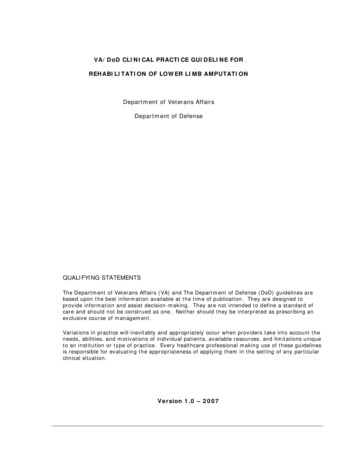
Transcription
VA/DoD CLINICAL PRACTICE GUIDELINE FORREHABILITATION OF LOWER LIMB AMPUTATIONDepartment of Veterans AffairsDepartment of DefenseQUALIFYING STATEMENTSThe Department of Veterans Affairs (VA) and The Department of Defense (DoD) guidelines arebased upon the best information available at the time of publication. They are designed toprovide information and assist decision-making. They are not intended to define a standard ofcare and should not be construed as one. Neither should they be interpreted as prescribing anexclusive course of management.Variations in practice will inevitably and appropriately occur when providers take into account theneeds, abilities, and motivations of individual patients, available resources, and limitations uniqueto an institution or type of practice. Every healthcare professional making use of these guidelinesis responsible for evaluating the appropriateness of applying them in the setting of any particularclinical situation.Version 1.0 – 2007
Prepared by:THE REHABILITATION OF LOWER LIMB AMPUTATIONWorking GroupWith support from:The Office of Quality and Performance, VA, Washington, DC&Quality Management Directorate, United States Army MEDCOMVersion 1.0 – 2007
VA/DoD Clinical Practice GuidelineFor Rehabilitation of Lower Limb AmputationTABLE OF CONTENTSIntroduction1Guideline Update Working Group8Key Elements Addressed by the Guideline11Core Module20Module A: Preoperative Assessment and Management58Module B: Immediate Postoperative Rehabilitation74Module C: Pre-Prosthetic Rehabilitation84Module D: Prosthetic Training94Module E: Rehabilitation and Prosthesis Follow-Up103AppendicesAppendix A: Guideline Development ProcessAppendix B: Supporting Evidence for Pain ManagementAppendix C: Prosthetic PrescriptionAppendix D: Foot Care Interventions for Patients with AmputationsAppendix E: Pre-Surgical Education InterventionsAppendix F: Acronym ListAppendix G: Participant ListAppendix H: BibliographyTablesTable 1. Amputation Rehabilitation Health-Related OutcomesTable 2. Summary of Interventions in Rehabilitation PhasesTable 3. Pain Control in Phases of RehabilitationTable 4. Desensitization TechniquesTable 5. Residual Limb Management in Phases of CareTable 6. Patient Education Minimum StandardsTable 7. Patient Education Summary TableTable 8. Advantages and Disadvantages of Recommended Assessment ToolsTable 9. Categories of Wound Healing (adapted from Smith, 2004)Table 10. Centers for Medicare and Medicaid Services Functional Levels
VA/DoD Clinical Practice GuidelineFor Rehabilitation of Lower Limb AmputationIntroductionThe Clinical Practice Guideline (CPG) for the Rehabilitation of Lower LimbAmputation was developed under the auspices of the Veterans Health Administration(VHA) and the Department of Defense (DoD) pursuant to directives from theDepartment of Veterans Affairs (VA).VHA and DoD define clinical practiceguidelines as:“Recommendations for the performance or exclusion of specific procedures orservices derived through a rigorous methodological approach that includes: Determination of appropriate criteria such as effectiveness, efficacy,population benefit, or patient satisfaction; and Literature review to determine the strength of the evidence in relationto these criteria.”BACKGROUNDThe most common causes of major lower limb amputation at VA and DoD facilitiesare medical diseases such as peripheral vascular disease (PVD) and diabetes, andtrauma. The VA and DoD both have the obligation to ensure that all individuals withamputations receive the full range of high quality care and services specific to theunique circumstances facing an individual with lower limb amputation.Thisguideline is designed to address the key principles of rehabilitation and streamlinethe care for the patient with amputation who will eventually transition from a DoD toa VA facility.Diabetes and Vascular Disease-Related AmputationsDiabetes or PVD are the most common causes for lower limb amputation in agingveterans being cared for in VA facilities. The advanced age of this population is asignificant factor in determining successful outcomes in amputation rehabilitation.In part, this is often due to an aging related decrease in conditioning, cognition,nutritional status, and ability to heal wounds, as well as a loss of social support. Allof these factors must be considered in developing a care plan for the patient with alower limb amputation which will lead to successful prosthetic use and return toindependent living in the home environment. With a comprehensive rehabilitationprogram, which addresses the individual patient’s needs, abilities, and level ofmotivation, the older veteran with an amputation usually can achieve a maximallyindependent lifestyle. Some of these patients may not be candidates for prostheticuse and will require other significant adaptations in lifestyle and identification ofapproaches to creating a functionally independent environment for the individual.Aging veterans with amputations often have numerous comorbidities such ascardiovascular disease, hypertension, end-stage renal disease with dialysis, andarthritis. These conditions are often of a long-standing nature and, in many cases,are associated with inactivity and loss of mobility over the course of the disease.The patient’s general health status increases the challenge of amputationrehabilitation in this population. Not only must they be trained in a new skill, butthey must also be reconditioned so they can handle the increased demand ofIntroduction - Page 1
VA/DoD Clinical Practice GuidelineFor Rehabilitation of Lower Limb Amputationwalking with a prosthesis either as functional users (wearing the prosthesis for mostof the day), partial users (using the prosthesis only at home and the wheelchair foroutdoor activities), or non-users (not using the prosthesis at all or only sometimesmainly for cosmetic purposes).An amputation is frequently the end result of the disease process and in many casescan be prevented with appropriate care. An extensive effort is made to save a limbwhenever possible. In 2001, the VA developed a CD-ROM based training programtitled, “Preservation-Amputation Care and Treatment (PACT).”This programfocuses on preventing amputations by identifying veterans who are at risk andeducating them on the appropriate treatment and appropriate footwear. It providesan excellent resource for primary care staff involved in the care of a veteran who isat risk of requiring an amputation.Traumatic AmputationsThe second type of veteran addressed in this guideline has experienced a traumaticamputation such as that occurring from motor vehicle accidents or military combat(e.g., blast, shrapnel, gunshot). While improvements in antibiotics, immediatetrauma care, and advanced reconstructive surgical techniques have reduced theneed for some amputations, military service members continue to be at significantrisk of amputation after severe limb trauma as a result of military combat operation.Amputation continues to be, in some cases, the best option for these individualswho are typically initially treated at a DoD facility.Battlefield trauma has necessitated amputations since before the establishment ofmilitary medicine. Almost 21,000 major amputations were documented in the UnionArmy during the Civil War. Over 4,000 amputations were performed on U.S. servicemembers during World War I and almost 15,000 service members had majoramputations during World War II. Thousands of others lost body parts during theKorean, Vietnam, and Gulf Wars due to traumatic injuries and cold injuries, such asfrostbite. Even during peacetime, an estimated 50 military service members peryear experience traumatic amputations. Recent advances in body armor havecontributed to a higher survival rate from combat-related injuries, especially thosesecondary to blast. This has resulted in a higher percentage of service memberswith upper limb and/or multiple limb amputations.While the pathophysiology of traumatic amputation may be different thandysvascular amputation, rehabilitation strategies and prosthetic componentprescriptions for both should be goal oriented and maximize function and quality oflife.One of the many challenges in treating patients with a trauma-relatedamputation is to address the wide variety of comorbid injuries often resulting frommulti- or poly-trauma. In war-related amputations, additional injuries of peripheralnerves, disrupted blood vessels, retained shrapnel, heterotopic ossification,contaminated wounds, burns, grafted skin, and fractures require modifiedrehabilitation strategies in the training of activities of daily living (ADL) andambulation.Introduction - Page 2
VA/DoD Clinical Practice GuidelineFor Rehabilitation of Lower Limb AmputationGOALS AND OUTCOMESThe overall goal of amputation rehabilitation is to optimize health status, function,independence, and quality of life of patients with a lower limb amputation.The clinical practice guideline is designed to achieve several specific goals:1. Describe prosthetic training, physical conditioning, and psychosocialrehabilitation to maximize the patient’s function and quality of life.2. Describe appropriate interventions to optimize the patient’s physical functionafter an amputation (e.g., strength, aerobic endurance, and balance).3. Promote an interdisciplinary team approach that is patient focused.4. Revise existing clinical pathways to be consistent with current evidence-basedrehabilitation methods.5. Provide facilities with a structured framework of appropriate rehabilitationinterventions to improve the patient’s outcome and reduce current practicevariation.6. Establish priorities for future research efforts that will generate practice-basedevidence.7. Identify outcome measures that can ultimately be used to improve practice inthe field and in future guidelines.8. Assist in identifying priorities for research efforts and allocation of resources.Patient Health OutcomesThe Working Group defined outcomes that rehabilitation care should achieve in thecategories of postoperative pain, physical health, function, psychological supportand well-being, patient satisfaction, reintegration, and healthcare utilization. Table1. Amputation Rehabilitation Health-Related Outcomes describes health-relatedoutcomes in each category.Introduction - Page 3
VA/DoD Clinical Practice GuidelineFor Rehabilitation of Lower Limb AmputationTable 1. Amputation Rehabilitation Health-Related OutcomesPostoperativepain1. Reduce residual limb pain, improve effectiveness of coping,and reduce interference with daily function2. Reduce phantom limb pain3. Decrease consumption of narcotics (amount and type ofpain medications throughout the acute surgical and earlypre-prosthetic training phases)Physicalhealth4. Reduce the risk of adverse effects due to periods ofprolonged immobilization:a. Decrease contracturesb. Decrease incidence of pressure ulcersc. Decrease incidence of deep vein thrombosis5. Improve physical status (e.g., balance, normal range ofmotion especially at the hips and knees; increase strengthand endurance to maximize efficient use of a prosthesis)Function6. Improve functional status (e.g., independent bed mobility,independent transfer, wheelchair mobility, gait and safety)7. Improve ambulation (e.g., distance of ambulation, hours ofprosthetic wearing, use of an assistive device, and ability toascend/descend stairs)8. Improve quality of life/decrease activity limitation (e.g.,activities of daily living [ADL], recreation, physical activitybeyond ADL, community re-integration; and return tohome environment)Psychologicalsupport andwell-being9. Reduce psychological comorbidities pre- and postoperative(e.g., depressive and anxiety disorders)10. Improve the quality of life11. Decrease the physical and mental/emotional diseaseburdenPatientsatisfaction12. Improve satisfaction with the level of skills and levels ofindependence individual patients have been able to achieve13. For patients receiving prostheses, improve satisfaction withthe prosthesis (comfort, functionality, and cosmesis)14. Improve satisfaction with the progress of care and status rictions)15. Improve the discharge outcome (discharge to the leastrestrictive environment)16. Improve vocational outcomes17. Improve recreational participation18. Maximize community participationHealthcareutilization(length ofstay)19. Optimize the length of rehabilitation stay20. Optimize the time from prosthetic fitting to reaching themobility goals, regardless of the process of rehabilitation21. Increase life-long follow-upIntroduction - Page 4
VA/DoD Clinical Practice GuidelineFor Rehabilitation of Lower Limb AmputationSCOPE AND APPROACHThe development process of this guideline follows a systematic approach describedin “Guideline for Guidelines,” an internal working document of VHA’s NationalClinical Practice Guideline Counsel. Appendix A clearly describes the guidelinedevelopment process.In developing the recommendations, the Working Group used available evidencewhenever possible. However, it was also necessary to rely heavily on the consensusof experienced VA/DoD healthcare providers and anecdotal evidence. The diversebackgrounds and interdisciplinary nature of the group provided an appropriatebalance in the attempt to avoid bias in formulating the recommendations.This Guideline is the product of many months of diligent effort and consensusbuilding among subject matter experts from the Department of Veterans Affairs(VA), Department of Defense (DoD), academia, and guideline facilitators from theprivate sector. An experienced moderator facilitated the multidisciplinary WorkingGroup.The Working Group members were physicians, nurses, physical specialists,prosthetists,psychologists, and educators involved in the rehabilitation of patients withamputations.Additional input was obtained from several clinical directors ofamputation clinics in the VHA.Target PopulationThe target population for this guideline was defined at the outset of the process.The guideline provides care recommendations for adult patients with a lowerextremity amputation (bilateral and unilateral) including through-hip, transfemoral,through-knee, transtibial, through-ankle, and partial foot.The cause of theamputation may be traumatic (combat or non-combat-related), or non-traumatic(dysvascular, neuropathy, carcinoma, or infection). Management of patients withpolytrauma, including head injuries, who require a lower limb amputation presentadditional complications that are not addressed in this guideline.Target AudienceThis guideline is written for individual providers who are part of the medicalrehabilitation team representing multiple disciplines: physiatry, surgery, physicaltherapy, occupational therapy, nursing, behavioral medicine or mental health,prosthetics, social work, nutrition, case management, and primary care (for longterm follow-up), as well as patients and their support system. The guideline alsoprovides a framework for organizing rehabilitation care provided in a variety ofenvironments, including inpatient rehabilitation units, physical medicine andrehabilitation (PM&R) departments, post-amputation clinics, prosthetic services,primary care practices, and long-term care facilities.Care for patients with a lower limb amputation (traumatic and non-traumatic) iscomplex and requires interdisciplinary management from multiple healthcarespecialties. Recommendations in this guideline are not specific to individual teammembers or disciplines; they are patient-centered and describe the patient’s needsat each step of rehabilitation care.This approach is intended to supportIntroduction - Page 5
VA/DoD Clinical Practice GuidelineFor Rehabilitation of Lower Limb Amputationinterdisciplinary communication and practice among team members to ensure asuccessful surgical outcome and rehabilitation process.DEVELOPMENT PROCESSAn initial literature search was conducted to identify relevant published studies inthe past ten years. The search was designed to identify the best available evidenceand ensured maximum coverage of studies at the top of the hierarchy of studytypes: evidence-based guidelines, meta-analyses, systematic reviews, andrandomized trials. The search did not identify any published clinical practiceguidelines that address lower limb amputation rehabilitation. In addition, very fewof the source documents used an evidence-based approach. A large body ofresearch was beyond the scope of this guideline. It is related to surgical proceduresand the scientific engineering of prosthetic manufacturing (technical, mechanical,and design issues of prosthetic limbs and components).The initial literature search revealed very limited research specific to the topic ofrehabilitation (physical and functional) following lower limb amputation. Publishedliterature has primarily consisted of epidemiologic surveys, cross section descriptivestudies, clinical commentaries, single-group cohort studies, and case studies, withrandomized controlled trials (RCT) noticeably absent.Recognizing the limitations identified in the initial searches, the actual literaturereview for this guideline focused on three specific questions: the management ofpain control, the strategy of postoperative residual limb management (e.g., postoperative dressing), and behavioral health interventions throughout therehabilitation process. The search covering the period 1995 - 2006 was conductedto identify original articles of clinical trials and empirical data evaluating efficacy andharm of intervention in the three areas. Abstracts of all studies were reviewed bymembers of the Working Group and the full text of ninty six RCTs was retrieved.Additional studies were supplied by the Working Group members, as well asbibliographic follow-ups of the retrieved studies. The studies were appraised fortheir quality and the results were summarized in 3 reports that were used by theWorking Group as the evidence base for formulating the recommendations.In general, the available trial studies were characterized by some methodologicallimitations that impact the ability to generalize the findings to the target populationof this guideline (patients served by both the VA and DoD). These include: Lacks of standard protocols and tends to focus on only a few outcomes usingnonstandardized measures of function and quality of lifeInconsistent definitions of outcome measures that lead to difficulties inevaluating and comparing studiesInadequate study duration; especially in the domain of community usage ofdevices Large proportions of subjects are lost to long-term follow-up Lack of homogeneity in patient populations, since patients have uniquemedical and surgical issues that greatly individualize their care and are alsocharacterized by unique social and emotional support resources.Based on the limited body of evidence in the literature that met rigorous scientificcriteria, the Working Group developed recommendations to address lower limbamputation rehabilitation. The Working Group used methods adapted from the U.S.Introduction - Page 6
VA/DoD Clinical Practice GuidelineFor Rehabilitation of Lower Limb AmputationPreventive Services Task Force for grading strength of evidence and ratingrecommendations (see Appendix A) for the recommendations included in thesethree sections of the guideline. The strength of recommendations (SR) appears inbrackets at the end of each recommendation for these three sections.Therecommendations in all other annotations were based on consensus of expertopinion.A questionnaire was also prepared and disseminated to practicing professionalswithin both the VA and DoD who work directly with patients who have had lowerlimb amputations. An effort was made to reach a maximum number of individualsfrom the various disciplines that provide care and services to this population. Theseprofessional staff members were queried as to care in all phases of rehabilitation ofpatients with amputation. In addition, they were asked to share testing techniquesand approaches that they have found to be especially successful in working withpatients with lower limb amputations. The results of the survey were kept from theWorking Group to avoid bias and were compared to the final list ofrecommendations that emerged from the group discussions. The summary list ofinterventions was compared and consolidated with the results of the survey.(Table 2. Summary of Interventions in Rehabilitation Phases)The draft document was discussed in two face-to-face group meetings and throughmultiple conference calls over a period of six months. The final document is theproduct of those discussions and has been approved by all the members of theWorking Group. The final draft document was reviewed by a diverse group ofexperts and by independent peer reviewers, whose input was also considered. Thefinal document was submitted for review and approval by the VA/DoD EvidenceBased Practice Working Group (see Appendix A).The list of participants in the Working Group is included in Appendix G to theguideline.ImplementationThe guideline and algorithms are designed to be adapted to individual facility needsand resources. It is expected that this guideline will provide information useful forimproving amputation care by reducing variability. Providers may use the algorithmsto determine best interventions and steps of care for their patients to optimizehealthcare utilization and achieve the best outcomes related to rehabilitationfollowing lower limb amputation. This should not prevent providers from using theirown clinical expertise in the care of an individual patient. Guidelinerecommendations should facilitate, not replace, clinical judgment.This guideline represents a first attempt in providing a structure for a rehabilitationprocess in lower limb amputation that is evidence-based. As rehabilitation practiceis evolving, new technology and more research will improve rehabilitation care inthe future. The clinical practice guideline can assist in identifying priorities forresearch efforts and allocation of resources. As a result of implementing a moreunified approach to rehabilitation practice, followed by data collection andassessment, new practice-based evidence may emerge.Introduction - Page 7
VA/DoD Clinical Practice GuidelineFor Rehabilitation of Lower Limb AmputationGuideline Update Working GroupGUIDELINE UPDATE WORKING GROUPVADoDDonna J. Blake, MDGary E. Benedetti, MDSteve M. Brielmaier, MSPTLinda A. Coniglio, MS, OTRJoseph Czerniecki, MDJohn Fergason, CPOHelene K. Henson, MDScott W. Helmers, MDMargaret J. Kent, PTJennifer S. Menetrez, MDMartin L. McDowell, BS, LPO, CPOJoseph Miller, MS CPLief Nelson, PTJanet A. Papazis, MPTAl Pike, CPPaul F. Pasquina, MDCindy E. Poorman, MSPTRobert J. Wilson, PsyDJames F. Roper Jr., MDSheila Saliman, PhDBarbara J. Sigford, MDDeborah J. Velez, GNP, MNMarilyn Weber, MDFACILITATOROded Susskind, MPHHEALTHCARE QUALITY INFORMATICS, INC.Martha D’Erasmo, MPHRosalie Fishman, RN, MSN, CPHQJoanne Marko, MS, SLP* Bolded names are members of the Editorial Panel.Additional contributor contact information is available in Appendix G.Introduction - Page 8
VA/DoD Clinical Practice GuidelineFor Rehabilitation of Lower Limb AmputationHow to Use this GuidelineThe design and implementation of any management strategy for lower limbamputation requires an understanding of the time frame of recovery.Thepostoperative continuum does not separate easily into "phases," yet for thepurposes of this guideline, phases have been defined to facilitate discussion of howthe goals evolve throughout the process. Although progression through thesephases is largely individualized, the time needed to progress is consistently reportedto be between 12 and 18 months. Several facets of care will need to be consideredand managed including medical and surgical issues, changes in limb volume,prosthetic fitting and training, social reintegration, life planning, and goal setting.The guideline has been organized with an initial presentation of a Core Module thatcuts across all phases and Modules A-E that correspond to the individual phases ofcare. Each of the modules (except the Core) includes an algorithm which describesthe step-by-step clinical process of decisions and interventions that occur in eachphase of care. Specific recommendations for each step in the algorithm are includedin an annotation section attached to each algorithm.CORE:The CORE module includes recommendations in those disciplines that areapplied continuously throughout all phases of care (e.g., pain management,behavioral health and rehabilitation intervention).The links to theserecommendations are also embedded in the relevant specific steps in thealgorithms for each phase of rehabilitation care in Modules A through E.Module A: Preoperative Phase. The preoperative phase starts with the decision toamputate. This phase includes an assessment of the patient’s health andfunctional status and decisions about strategies that will be appliedpostoperatively (e.g., pain management and dressing). In addition, theconsideration of amputation level selection, preoperative education,emotional support, physical therapy and conditioning, nutritional support,and pain management occur in this phase of care.Module B: Immediate Postoperative Phase. The acute hospital postoperative phase isthe time in the hospital after the amputation surgery, ranging fromapproximately 5 to 14 days. This module addresses common postoperativerecovery concerns which include such things as hemodynamic stability,wound healing and prevention of early complications, and additional specificinterventions such as care of the residual limb, patient education, physicaltherapy (to include patient safety, initial mobility, positioning, and transfers),occupational therapy, and behavioral health.Module C: Pre-Prosthetic Rehabilitation Phase. In general, this phase begins withdischarge from acute care once the patient is medically stable and mayextend up to 6 to 12 weeks after surgery. The focus of concern shifts fromthe surgical and medical issues to rehabilitation. Rehabilitation will focus onmaximizing physical function as well as social function concerning dailyactivities, and re-integration to home and community. Rehabilitation at thisphase is aimed at improving the patients’ function to enable them to achievetheir goals with or without prosthesis.Introduction - Page 9
VA/DoD Clinical Practice GuidelineFor Rehabilitation of Lower Limb AmputationModule D: Prosthetic Training Phase. This phase starts when the first prosthetic deviceis fitted. The most rapid changes in residual limb volume occur during thisphase due to the beginning of ambulation and prosthetic use.Theimmediate recovery period begins with the healing of the wound and usuallyextends 4 to 6 months from the healing date. This phase includes gaittraining, rehabilitation intervention, and emphasis on integration into thecommunity and vocational and recreational activities. This phase generallyends with the relative stabilization of the residual limb size as defined byconsistency of the prosthetic fit for several months.Module E: Rehabilitation and Prosthesis Follow-up Phase. Limb volume will continue tochange to some degree, for a period of 12 to 18 months after the initialhealing.This will likely require adjustments to the prosthetic socket,necessitating access to a skilled prosthetist, with frequent visits during thefirst year of prosthetic use. In this phase, the patient moves toward socialreintegration and higher functional training and development, and becomesmore empowered and independent from his or her healthcare provider. Thisphase is not defined by an end-point. Special efforts should be made tofollow up with the patient beyond the first year. Continued assessment andinterventions to prevent further amputation and secondary complications aswell as promoting care of the residual and contralateral limbs are part of thelife-long care for the patient with a lower limb amputation.Interdisciplinary Team ApproachCare for the patient with amputation (traumatic and non-traumatic) is complex andrequires multiple medical, surgical, and rehabilitation specialties.Aninterdisciplinary team approach to lower limb amputation rehabilitation remainsvital. In addition to the patient, members of the medical rehabilitation team willmost likely include the patient’s support system, surgeon, physiatrist, physicaltherapist, occupational therapist, recreational therapist, prosthetist, nurse, socialworker, behavioral health specialist, peer support visitors, and case manager. Eachmember has important roles and responsibilities in optimizing pre- andpostoperative rehabilitation.Achieving maximum recovery and optimal function after limb-loss demandsincreased efforts by the various providers to communicate on behalf of the patient.Communication among team members can be challenging as the patient may visitvarious team members at different locations in the same day.The recommendations in this guideline are patient-centered and describe theintervention that should be taken by the medical rehabilitation team at each step ofthe care. Table 2. Summary of Interventions in Rehabilitation Phases includes amatrix of the key interventions that occur at each phase, organized by disciplines.Introduction - Page 10
VA/DoD Clinical Practice GuidelineFor Rehabilitation of Lower Limb AmputationKey Elements Addressed by the Guideline1.Defines the phases of rehabilitation care and the steps included ineach phase.2.Recognizes the importance of comprehensive interdisciplinaryassessment of the patient before and after surgery andunderstanding the physical and social support system.3.Recognizes the importance of the decision about the appropriatelevel of amputat
The most common causes of major lower limb amputation at VA and DoD facilities are medical diseases such as peripheral vascular disease (PVD) and diabetes, and trauma. The VA and DoD both have the obligation to ensure that all individuals with amputations receive the full range of high quality care and services specific to the

